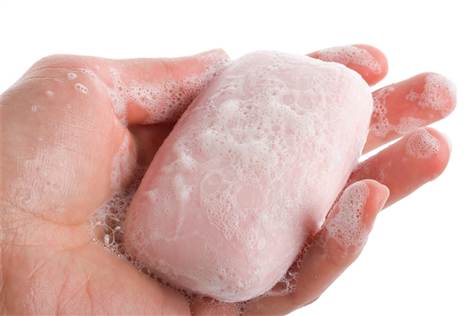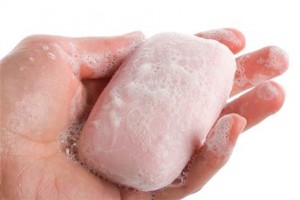Survival School – Soap Is Your Friend
Summary
 Keeping clean in the Z-pocalypse may seem extremely futile. It would be a shame, though, for any of our ZSC brigadiers to succumb to disease and infection from something mundane when charged with the task of staying one step ahead of the undead menace.
Keeping clean in the Z-pocalypse may seem extremely futile. It would be a shame, though, for any of our ZSC brigadiers to succumb to disease and infection from something mundane when charged with the task of staying one step ahead of the undead menace.

by R.C. Murphy
 Keeping clean in the Z-pocalypse may seem extremely futile. It would be a shame, though, for any of our ZSC brigadiers to succumb to disease and infection from something mundane when charged with the task of staying one step ahead of the undead menace.
Keeping clean in the Z-pocalypse may seem extremely futile. It would be a shame, though, for any of our ZSC brigadiers to succumb to disease and infection from something mundane when charged with the task of staying one step ahead of the undead menace.
We highly recommend adding biodegradable soap in bar and liquid form to your go bags—not just in your camping gear, but the bag you plan to carry on your person at all times. It is important to keep not only the dishes to you cook and eat with clean, but your clothes and body as well. Below are the best methods for keeping clean without polluting the water source you draw from.
Before you begin washing anything in camp, establish a gray water pit at least 200 feet from your primary water source and away from the camp kitchen to avoid contamination after cleaning. Dig a hole deep enough for the camp’s estimated water usage. Save the excess dirt. When the gray water pit is full or you plan to move camp, cover the pit. This will prevent animals from drinking the soapy water. It will also keep the rain from washing the soap into the nearest water source. Even biodegradable soap can pollute water, poisoning fish and altering the bacteria necessary for the ecosystem in the water.
If the water source is destroyed, you obliterate your chances of surviving. Purifying and boiling will not make gray water or water polluted by soap drinkable.
Washing the Dishes:
There are two methods for washing the dishes. The first is for a small amount of dishes; the second is ideal for large camps that pool resources and chores.
Washing Method #1 (Small campsites)-
- In a clean pot, bring at least a liter of water to a rolling boil for over a minute. Allow the water to cool to a temperature you can handle it and move the pot beside the gray water pit.
- Using as little biodegradable soap as possible and a clean rag, scrub the cooking utensils and rinse with purified (boiled) water. Make sure all water goes into the pit. (Tip: use a ladle or transfer the water to a bottle for easy, controlled pouring.)
- Repeat the scrubbing and rinsing routine with the pots, pans, etc.
- Scrub the silverware and rinse in the water left in the pot.
- Dump out the rest of the water into the gray water pit.
- Leave the dishes to dry somewhere dust-free. Ensure they are completely dry before storing.
Washing Method #2 (Large campsites)-
- Fill three plastic tubs or pots thusly: Pot #1 – 2 liters hot water with biodegradable soap (for washing). Pot #2 – 1 liter hot water (rinsing). Pot #3 – 1 gallon cold water with 12 teaspoons chlorine bleach (sanitizing).
- Scrape excess food off of all plates and pans. If food sticks to the pan, fill with water and bring to a boil to loosen it.
- Wash in pot #1, using a clean rag. Start with the least soiled items (silverware, cups, etc) to keep the water clean longer.
- Rinse in pot #2.
- Sanitize in pot #3 for a minimum of 2 minutes. Make sure items are completely submerged.
- Leave out to fully dry in a dust-free place before storing.
- Dump used water into the gray water pit.
Cleaning Laundry:
- Bring a pot of water to a rolling boil for at least 1 minute.
- Read the labels on your clothing. (The Z-pocalypse is not the time to shrink your only pair of jeans by accident.) If your clothes all say “Wash, cold water” let the water cool all the way. Use warm water, otherwise.
- Add a small amount of biodegradable soap to the water and mix. Do not use detergent. It will pollute the water supply and make animals sick, even with proper grey water disposal.
- Submerge the laundry and agitate (stir) using your hand or tongs for a few minutes. Clothing with excess staining will need to be scrubbed with a small amount of soap prior to putting them in the pot to wash. Do not use hot water on bloodstains, even zombie blood.
- Remove clothes from the pot and carefully wring out excess water.
- Hang to dry.
- Dispose of wash water in the gray water pit.
- Wash the pot and tongs as described in Dishwashing Method #1 above.
Tip: This technique may also be done in a shallow hole lined with a tarp if a pot or tub is not available.
Washing Yourself
 Smelling like a zombie isn’t the only concern we’ll face while on the run from the undead. There are a number of nasty parasites and diseases that can make people seriously ill if they do not bathe regularly. The Z-pocalypse is not the time to skip a shower. Unfortunately, it will be the most difficult time to try and take one.
Smelling like a zombie isn’t the only concern we’ll face while on the run from the undead. There are a number of nasty parasites and diseases that can make people seriously ill if they do not bathe regularly. The Z-pocalypse is not the time to skip a shower. Unfortunately, it will be the most difficult time to try and take one.
One can get by for the first few chaotic days by keeping unscented baby wipes in your go bag and taking what amounts to a spit bath twice a day. Dispose of the wipes in the garbage. Do not burn them, the pieces could catch in the wind and start a fire.
After a few days of not-really-bathing, you’ll beg for as close to a shower as you can get. Purify a gallon of water (boil for a minute and cool, you know the routine by now) and find yourself a place reasonably private to wash up, at least 200 feet from your water source. Use biodegradable soap (most handmade soaps fit this bill) and a clean washcloth to bathe. Yes, use this soap on your hair, as well. You only need to wash the roots of your hair. Rinsing will push the soap down the rest of your hair to clean it. Bathe using actual water at least three times a week to keep healthy.
Do not mistake dipping into a lake as taking a bath. Water alone will not kill the pathogens that cling to human skin and hair. And lake water is full of other microbes that can make you ill. Basically, if water is touching you in any way, purify it first.

